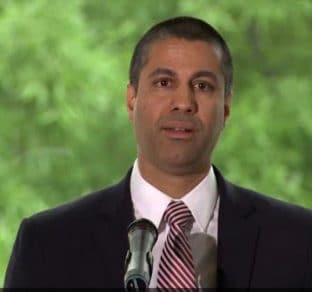Thursday, Dec. 14 is a big day for the Federal Communications Commission. With “net neutrality” set to disappear through legislation Republicans believe will “restore internet freedom,” the FCC has issued guidelines as to how the public can view the meeting or attend in person.
The end of “net neutrality” isn’t the lone Hot Button topic up for discussion. The future of TV broadcasting is also up for a vote.
The Commission’s Open Meeting, set to be a media circus, begins at 10:30am with the likely adoption of new rules for broadcast media when local law enforcement is in a dangerous situation.
This Public Safety & Homeland Security item involves the consideration of a Report and Order that would amend the Commission’s Emergency Alert System (EAS) rules to add a dedicated event code to facilitate the delivery of Blue Alerts over the EAS and Wireless Emergency Alert system.
If approved, Blue Alerts would deliver actionable information to the public when a law enforcement officer is killed, seriously injured, missing in connection with his or her official duties, or if there is an imminent and credible threat to a law enforcement officer.
Then comes a Wireline Competition NPRM and Order to strengthen the Rural Health Care Program and improve access to telehealth in rural America, and a Wireless Telecommunications item considering a Public Notice seeking input on a draft Program Comment addressing the historic preservation review requirements for collocating wireless communications facilities on certain communications towers.
With that, the Commission will address WC Docket No. 17-108 — the “Restoring Internet Freedom” Order. It is likely to be approved on a party-line 3-2 vote; Democratic Commissioners Jessica Rosenworcel and Mignon Clyburn have nevertheless been vocal in their fierce opposition to the Order, taking to Twitter to drive their views to critical mass.
The Declaratory Ruling, Report and Order, and Order will “restore Internet freedom” by returning broadband Internet access service to its prior classification as an information service, removing Title II classification, and reinstate the private mobile service classification of mobile broadband Internet access service.
The item also eliminates the Commission’s “vague and expansive Internet Conduct Standard, along with the bright-line rules.” Additionally, the GOP-led FCC insists, it will modify the transparency rule to promote additional transparency, while eliminating burdensome and unnecessary requirements.
Once this vote is cast, the Commissioners will then consider a Report and Order to harmonize the Commission’s rules by eliminating the commercial mobile radio service (CMRS) presumption, to be consistent with our flexible use approach to licensing.
This will then see consideration of a NPRM seeking comment on ways to modernize certain notice provisions in Part 76 of the FCC’s Rules governing multichannel video and cable television service.
For broadcast media, the most important matter of the day may not come until well after 1pm Eastern. The final agenda item will see the Commissioners consider a Notice of Proposed Rulemaking seeking comment on whether to modify, retain or eliminate the 39% national audience reach cap and/or the UHF discount used by broadcast television station groups to calculate compliance with the cap.
While Democrats will be vociferous in their opposition to the NPRM, they will likely go down in defeat on a party-line 3-2 vote.
This could rev the engines on the eventual elimination of the audience cap — or fortify them, based on the level of response and volume of comments set to come in the coming weeks.
However, given the GOP majority, the loosening of the cap — an essential to Sinclair Broadcast Group‘s acquisition of Tribune Media — is all but assured at the FCC.
While that’s a matter of months, “net neutrality” will end 30 days from its publishing in the Federal Register — and that’s what the nation will focus its attention on in under 24 hours.
.





